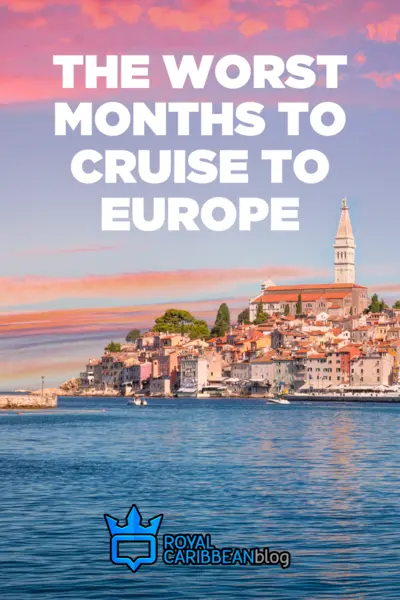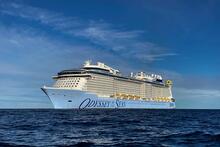If you’re planning a cruise to Europe, there are a few months you’ll want to avoid. Whereas some months offer pleasant weather and lower prices, others come with outrageous crowds and unbearable heat.

Cruising to Europe is quite different than cruising the Caribbean. Caribbean cruises are all about the beach, and most passengers spend their port days sunbathing and swimming. European cruises, on the other hand, focus on sightseeing in bustling cities and quaint towns across the continent.
Whether sailing through the fjords of Norway, island hopping through Greece, or touring the Colosseum in Rome, there are endless ways to discover Europe’s highlights on a cruise vacation.

European cruises are a dream for many cruisers, so it’s important to plan your vacation during the best months of the year. Royal Caribbean offers European cruises from April to October, and while there’s no “wrong” month to visit, not all months will offer the same experience.
These are the worst months to plan a European cruise based on weather conditions, the amount of crowds, and the itinerary you select.
If you’re cruising to southern Europe, the worst months to visit are July and August

During the initial planning stages of a European cruise, you might assume the peak of summer is the best time to book a sailing. After all, you’re dreaming of sipping wine in a sunny Italian piazza, not bundling up in a parka in Greenland.
And while summer can be a great time to visit Europe, it can also be extremely hot and crowded. For those booking cruises in southern Europe—Mediterranean and Adriatic itineraries—summer heat waves are a major concern.
It’s not uncommon to see temperatures in the high 80s and even low 90s in cities like Palermo and Valencia during the months of July and August. Although these temperatures may be tolerable on a beach vacation, they are anything but ideal when sightseeing in European cities.

Roaming the ancient streets of Pompeii or touring the Acropolis in August’s blazing heat is enough to exhaust any cruiser. If you must cruise to Europe in the peak of summer, take caution when booking shore excursions.
If drastic temperatures are forecasted, consider booking excursions on the water rather than in the city, such as a catamaran tour around Santorini or beach day in Positano.
Related: 30 Best European cruise tips
Additionally, consider bringing extra clothes to change into when visiting cathedrals. Although it’s required to cover your shoulders and knees in the Sistine Chapel, you don’t need to cover up all day—if you do, you could potentially overheat.
Instead, pack a scarf and a lightweight skirt or pair of pants in your day bag that you can quickly put over your clothes before entering religious sites.
Not only are temperatures high in the summer, but crowds are at their peak, too
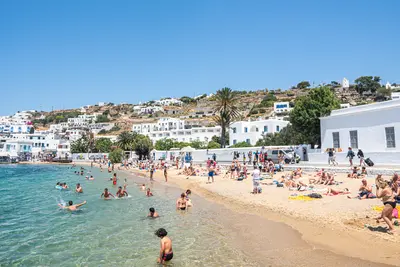
A European summer is a dream for many cruisers. After all, nothing screams relaxation quite like sipping a rosé along the French Riviera. And while summertime in Europe is undoubtedly dreamy, it comes with one major downside: massive crowds.
Whether in Santorini or Tenerife, you’re almost guaranteed to face large crowds in the summer. Not only will your cruise likely be fully booked, but shore excursions will book up quickly and you’ll be navigating your way around thousands of other visitors in each port of call.
August in particular can be an exceptionally busy time in Europe, as Europeans traditionally plan several weeks of vacation during the month. In August, you should plan to encounter even higher crowds than earlier in the summer, particularly in southern Europe.
Related: How to beat the crowds on your cruise ship

Truthfully, though, there’s a good chance you will not notice a difference between July and August crowds. Crowds are high in Europe throughout the peak season, and while there may be more crowds in August, it’s going to feel crowded during any summer month.
No one likes dealing with crowds, but they are inevitable when cruising to Europe in the summer. While they certainly aren’t bad enough to cancel your plans, you shouldn’t expect quiet, calm sightseeing days in port either.
Another con of cruising in July and August are the higher costs
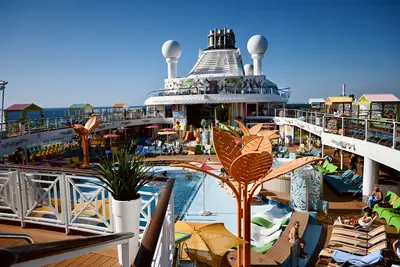
The last major downside of cruising to Europe in July and August are the higher costs. Due to the school calendar, most families plan European cruises in late June, July, and early August. Therefore, it’s no surprise that these months see the most demand, which results in higher prices.
Let’s look at a 7-night Western Mediterranean cruise on Allure of the Seas. You can expect to pay $400-500 more for a balcony cabin when cruising in July versus September. If your schedule is flexible, why not wait until September to cruise?
Related: How much does a European cruise cost?
Not only will there be fewer crowds, but you can put those savings toward a shore excursion or cruise add-ons like drink and dining packages.
Aside from the cost of your cruise fare, airfare prices peak in the summer. A roundtrip flight to Rome, for instance, might cost $900 in May, but could skyrocket to $1,500 in July. When traveling with a large group, these extra costs will easily add up.
The best months to cruise the Mediterranean and Adriatic are May, early June, and September
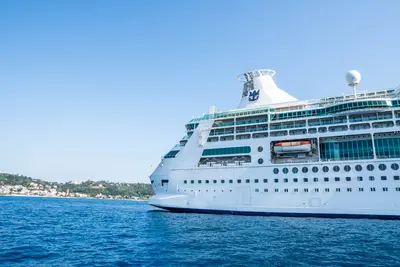
Knowing the drawbacks of cruising southern Europe in the peak summer season, what are the best months to cruise?
Generally speaking, the most favorable months for a cruise to the Mediterranean and Adriatic are May, early June, and September. During these months, you will find lower prices, more comfortable temperatures, and fewer crowds.
Related: Ultimate Greek Isles cruise guide
Because the school year is still in session in most of Europe and North America, you will see fewer families onboard, and the lack of demand leads to lower cruise fares. Plus, you’re less likely to spend your port days sweaty and miserable, as temperatures will generally be more mild (although that’s never guaranteed!).
While crowds will start to increase in June, sticking to the first half of the month is recommended, as crowds will not yet have hit their peak.
If you’re cruising in northern Europe, however, avoid sailings in early spring and late fall

Europe is a diverse continent, and the best time to cruise one region may be the worst for another. While some cruisers may book a sunny getaway to the Greek Isles, others are more interested in visiting ports like Amsterdam and Dublin.
Although sticking to the spring and fall is preferable for cruises to southern Europe, it should be avoided when visiting northern European countries. Simply put, the weather in these regions is more unpredictable, and the shoulder season can come with less-than-ideal conditions.
While that Norway itinerary in May might be the cheapest option, waiting until June, July, or August might bring sunnier skies and warmer temperatures. Unfortunately, this means spending more on your cruise fare and airfare, but it’s almost always worth the trade-off.
Should you cruise to Europe in October?
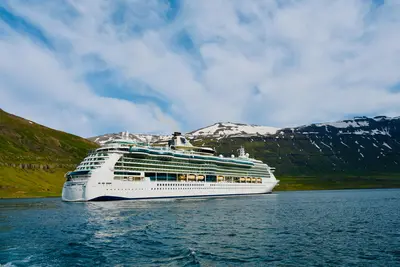
Royal Caribbean’s European cruise season usually ends in October, and like any month, October comes with its own set of advantages and disadvantages.
One plus of sailing in October is the weather. Unlike the scorching 90 degree days of August, you’ll find the weather more pleasant in the fall. Temperatures in Mykonos, as an example, are around 70 degrees in October compared to the mid-80s in August.
In addition, there will be fewer crowds in October compared to during the summer. Once the school year is back in session, European tourist attractions become quieter, making sightseeing days a little bit less hectic for visitors.
Related: What is the best time to cruise the Mediterranean?

As far as drawbacks, though, you will find fewer itineraries offered in October. During this month, Royal Caribbean begins to send its ships back to North America for the winter Caribbean season. By the end of the month, only a few ships remain in Europe, and almost all itineraries visit southern European destinations, where the weather is still comfortable in October.
Even with these drawbacks, October can be a fantastic time to cruise to southern Europe for those who want lower fares and fewer crowds.
Cruising is all about having the right mindset. With the right expectations, there’s no “best” or “worst” month to cruise to Europe

While there’s no denying that some months offer nicer weather conditions and crowd control than others, no time of year is completely perfect. Sure, May might offer excellent conditions for traveling to Sicily, but the same cannot be said about cruising to Iceland.
Even if you sail during the “worst” month to cruise to Europe, you will still, more than likely, have a wonderful cruise experience. For most cruisers, the highs of cruising to Europe far outweigh the lows.
Visiting 2000-year old archeological sites, tasting local delicacies, and being awestruck by breathtaking fjords can be worth the high temperatures and crowds.
If you board a European cruise expecting tranquil days in port and no lines at tourist sites, you’re going to be disappointed.
If you go in with an optimistic mindset, on the other hand, any month will provide a remarkable cruise vacation.
